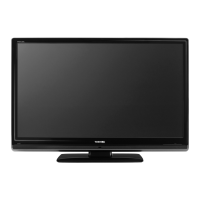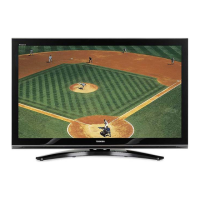
Do you have a question about the Toshiba 46SL733 and is the answer not in the manual?
| Display diagonal | 46 \ |
|---|---|
| Display brightness | 450 cd/m² |
| Native aspect ratio | 16:9 |
| Contrast ratio (dynamic) | 4000000:1 |
| Contrast ratio (typical) | 5000:1 |
| Product color | Black |
| Panel mounting interface | 400 x 200 mm |
| Audio system | Dolby Digital Plus |
| RMS rated power | 20 W |
| Number of speakers | 2 |
| HDMI version | 1.4 |
| PC in (D-Sub) | Yes |
| HDMI ports quantity | 4 |
| USB 2.0 ports quantity | USB 2.0 ports have a data transmission speed of 480 Mbps, and are backwards compatible with USB 1.1 ports. You can connect all kinds of peripheral devices to them. |
| Component video (YPbPr/YCbCr) in | 1 |
| Consumer Electronics Control (CEC) | Anynet+ |
| Analog signal format system | NTSC, PAL, SECAM |
| Power consumption (standby) | 0.2 W |
| Power consumption (typical) | 124.8 W |
| Power requirements | 220-240V/50/60Hz |
| Depth (with stand) | 329 mm |
|---|---|
| Height (with stand) | 761 mm |
| Weight (with stand) | 21500 g |
| Depth (without stand) | 50 mm |
| Width (without stand) | 1140 mm |
| Height (without stand) | 713 mm |
| Weight (without stand) | 18600 g |
Service manual for the Toshiba 46SL733 LCD Color Television.
Disclaimer regarding modification, alteration, and warranty of the provided information.
Instructions for downloading and installing the Autodesk DWF Viewer software.
Steps to adjust Internet Explorer security settings for optimal system operation.
Specifies the recommended PC, monitor, OS, and browser for using the system.
Describes how to view part information by clicking on parts in drawings.
Explains how to search for specific parts within the schematic diagrams.
Details how to trace signal lines and connector destinations within schematic diagrams.
Explains how to toggle layers for better visualization of schematic diagrams.
Describes the highlighting feature for tracing patterns on PC board views.
Explains how to print specific regions or tiled drawings from the viewer.
Details the preparation steps for setting up the service manual for network use.
Explains how to use the zeusFPch program to modify file paths for network access.
Instructions to confirm that the service manual operates correctly on the network.
Addresses compatibility issues with DWF Viewer versions and installation recommendations.
Provides a procedure to close unresponsive windows using Task Manager.
Advises on precautions when opening and interacting with diagrams to avoid issues.
Explains Toshiba's promotion of green procurement for environmentally friendly parts.
Emphasizes the mandatory use of lead-free solder for repairs and warns against lead-based solder.
Lists essential safety measures to be observed before and during chassis servicing.
Details the procedure for measuring touch current to ensure electrical safety after repairs.
Provides safety precautions and procedures for handling the LCD module to prevent damage and injury.
Provides essential notes on resistors, capacitors, and part replacement for schematic diagrams.
Step-by-step guide on how to access the TV's service mode using the remote control.
Instructions on how to navigate to the adjustment menu within the service mode.
Describes the special functions of remote control keys when the adjustment menu is displayed.
Explains how to navigate and select items for adjustment using the PROGRAMME button.
Details how to change data values using the VOLUME +/- buttons within the service mode.
Provides a table for converting binary bit values to hexadecimal data for settings.
Instructions on how to properly exit the service mode by turning off the TV.
Explains the necessary steps for initializing TV micro data after replacing the digital board.
Describes how to select built-in test patterns using the remote control in Service Mode.
Explains how to initiate a self-diagnosis check to verify IC interface execution.
Details the items and data formats displayed during self-check and version checks.
Explains TV model, MAC address, IP settings, and DHCP status.
Covers boot code, SW versions, EEPROM, and HDMI EDID checksums.
Lists various options available for customizing hotel settings like panel locks and volume limits.
Describes how to configure Hotel Mode settings using the TV's service menu.
Explains how to enable and configure Hotel Mode options through the TV's on-screen settings menu.
Details how to copy Hotel Mode settings to other TVs using a USB device via the Hotel Clone menu.
Describes the process of saving the configured hotel mode settings from the TV to a USB device.
Explains how to load saved hotel mode settings from a USB device back to the TV.
Explains the meaning of different LED states (Power, OnTimer, ProgramTimer) for TV status.
Provides instructions for upgrading DTV software via USB while the TV is in use.
Explains how panel identification markings relate to vendor and specific parts.
Provides precautions, notes on part numbers, and abbreviations used in the parts list.
Lists components for the U01AS MAIN (PE0840) board, including location, part number, and description.
Provides a reference of the remote control buttons and their functions for operating the television.
Describes the external input/output connections and physical control buttons on the television.
Guides the user through the initial setup process, including language and country selection.
Lists supported DVB-T systems and channel frequencies for various countries.
Details supported external connections like EXT, HDMI, PC, and input formats.
Provides specifications for screen size, power consumption, dimensions, and weight.
Lists the accessories supplied with the TV and optional accessories available.












